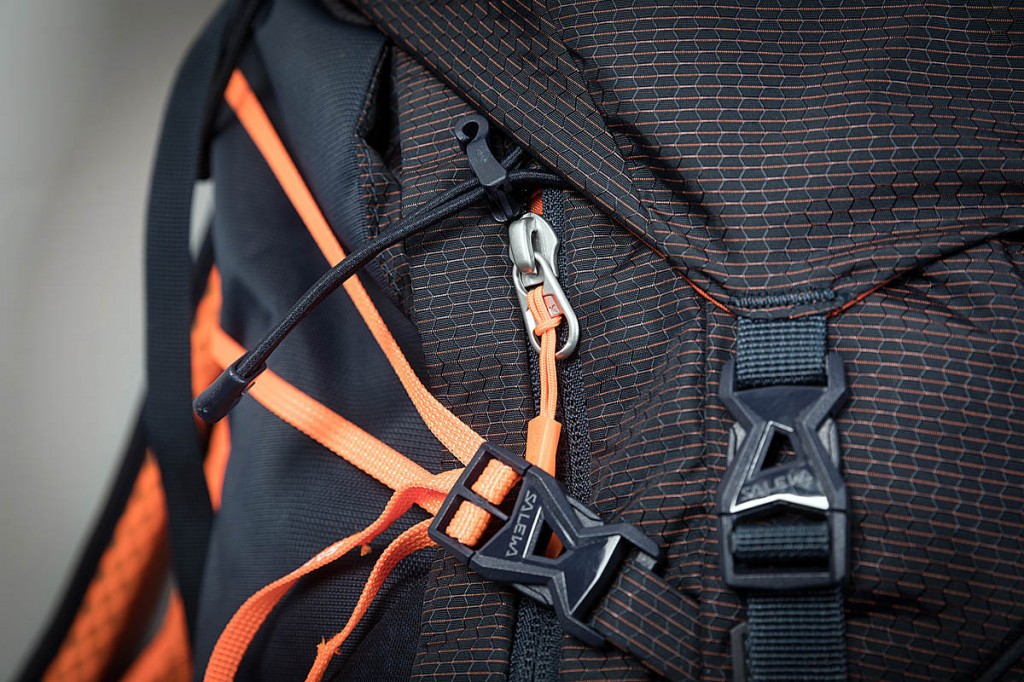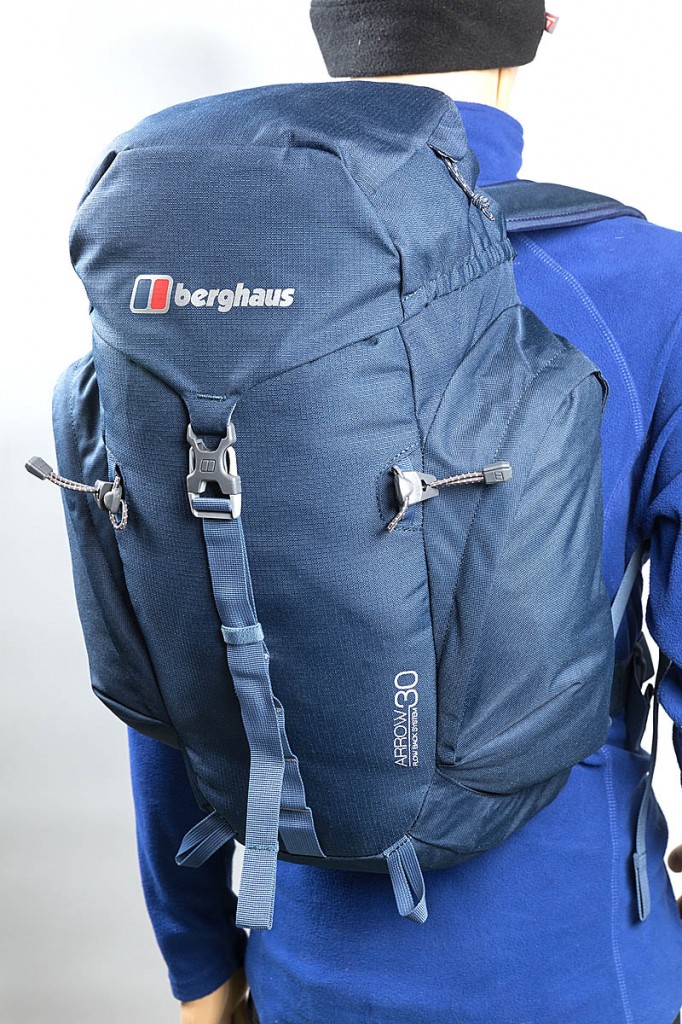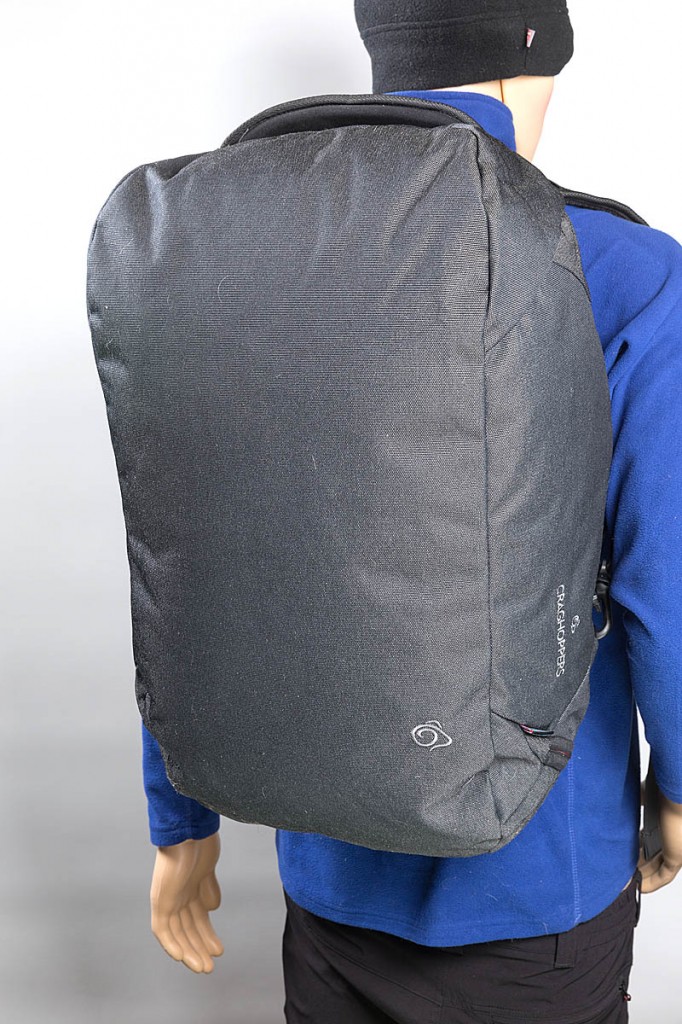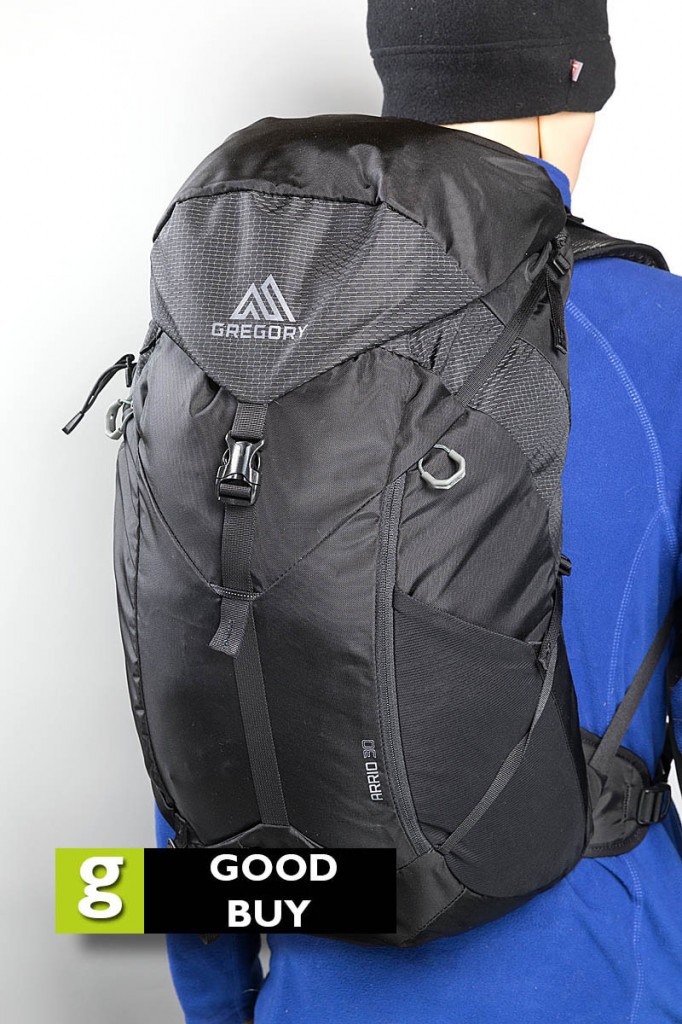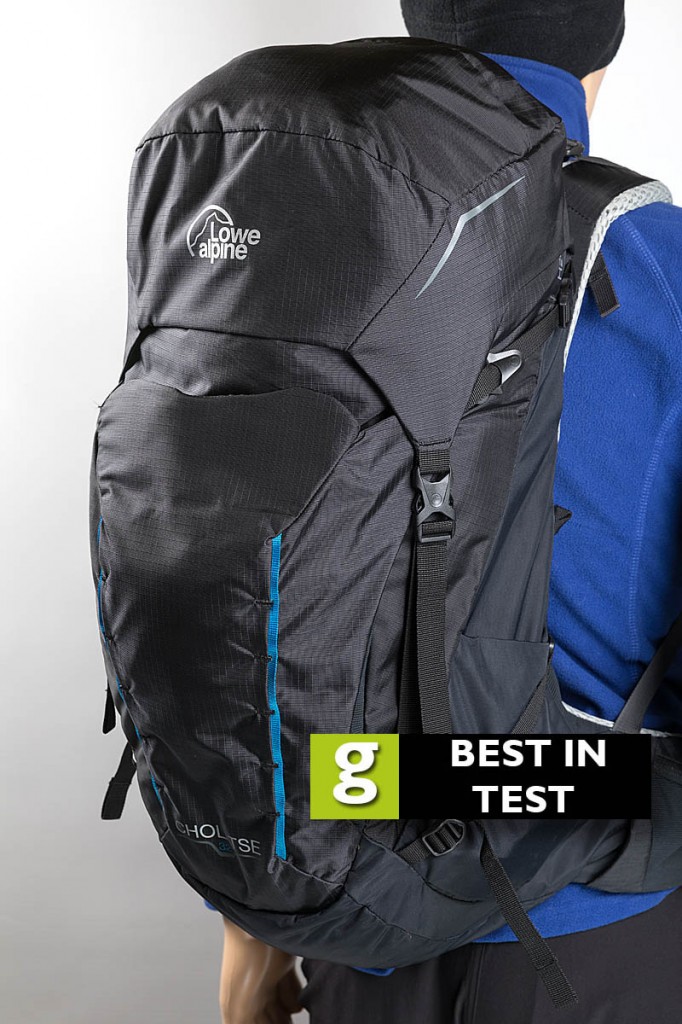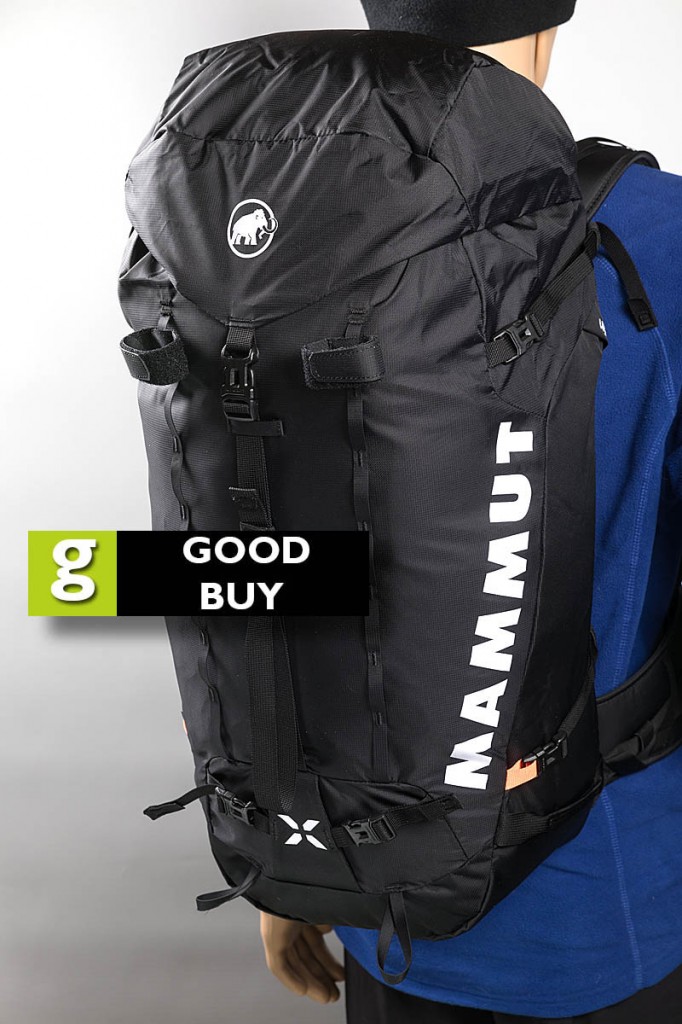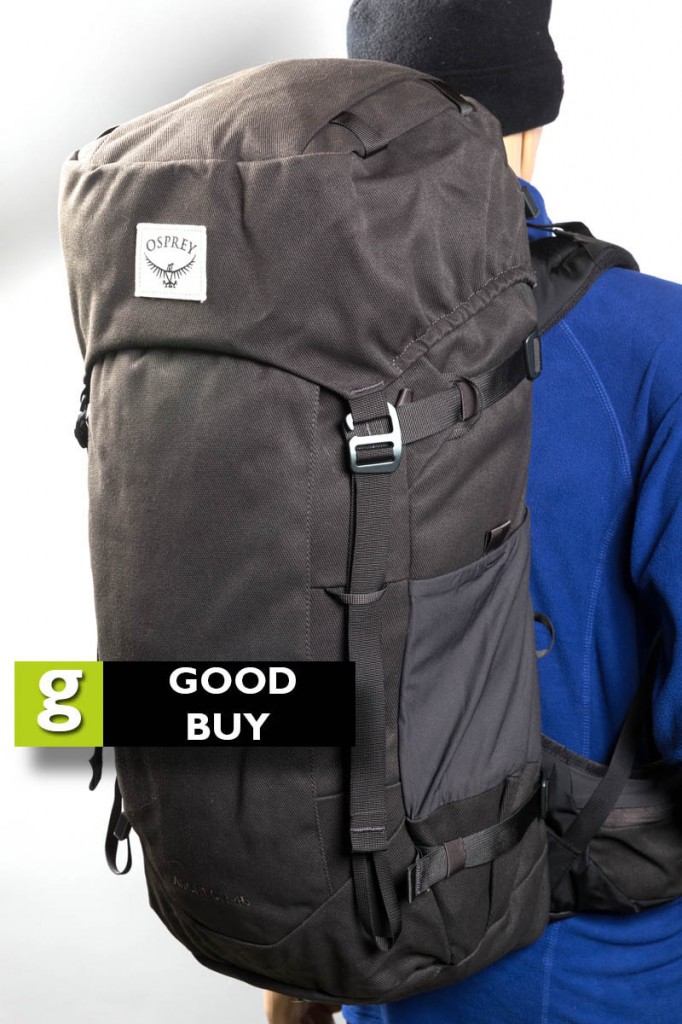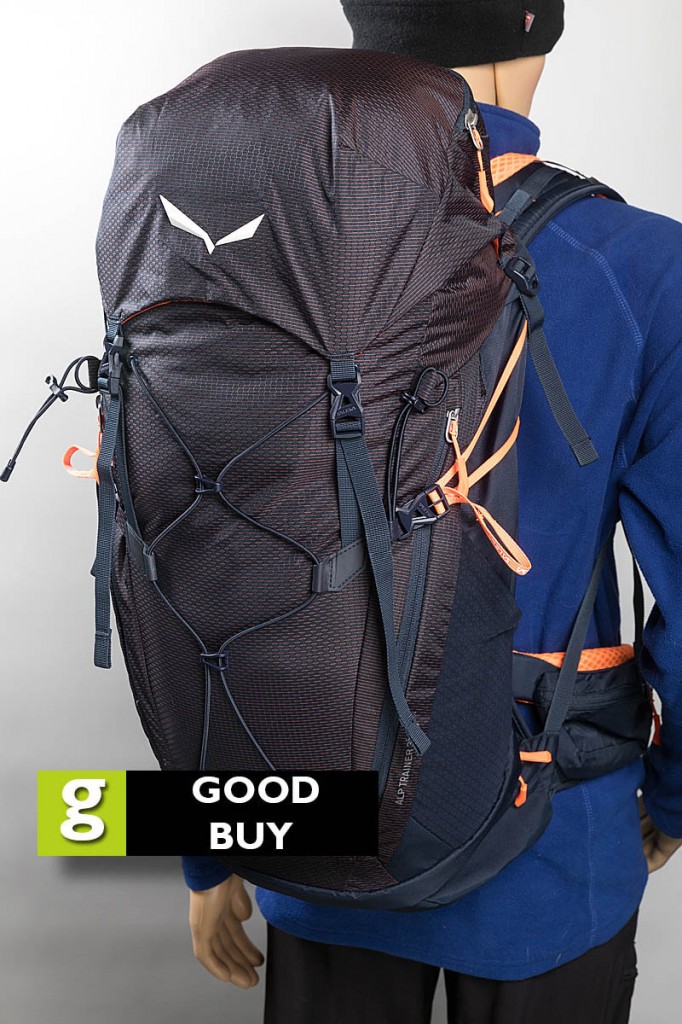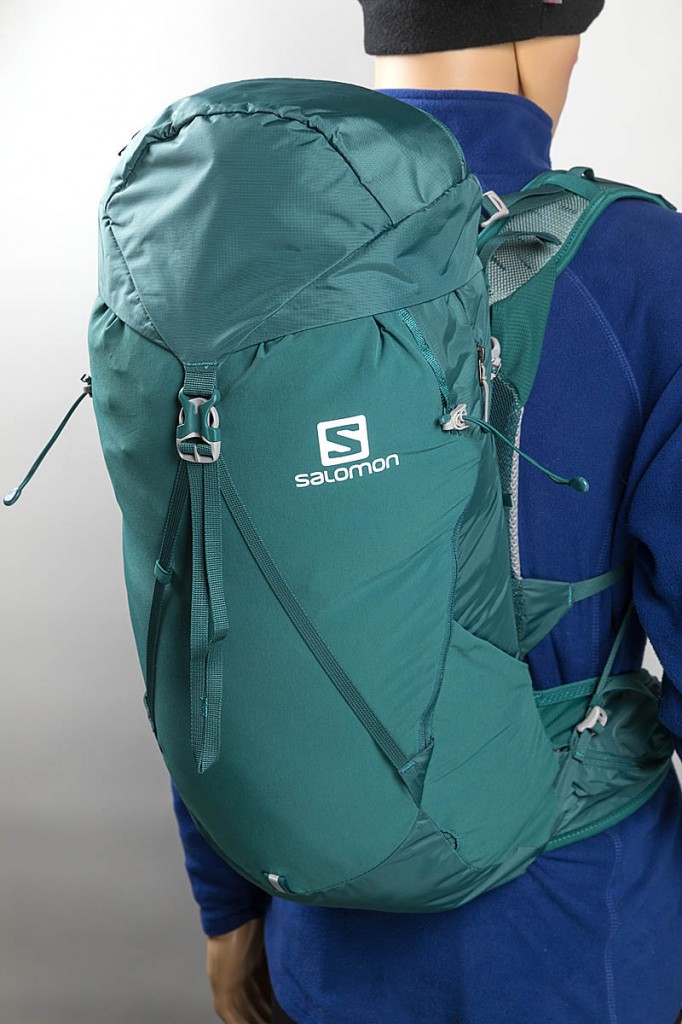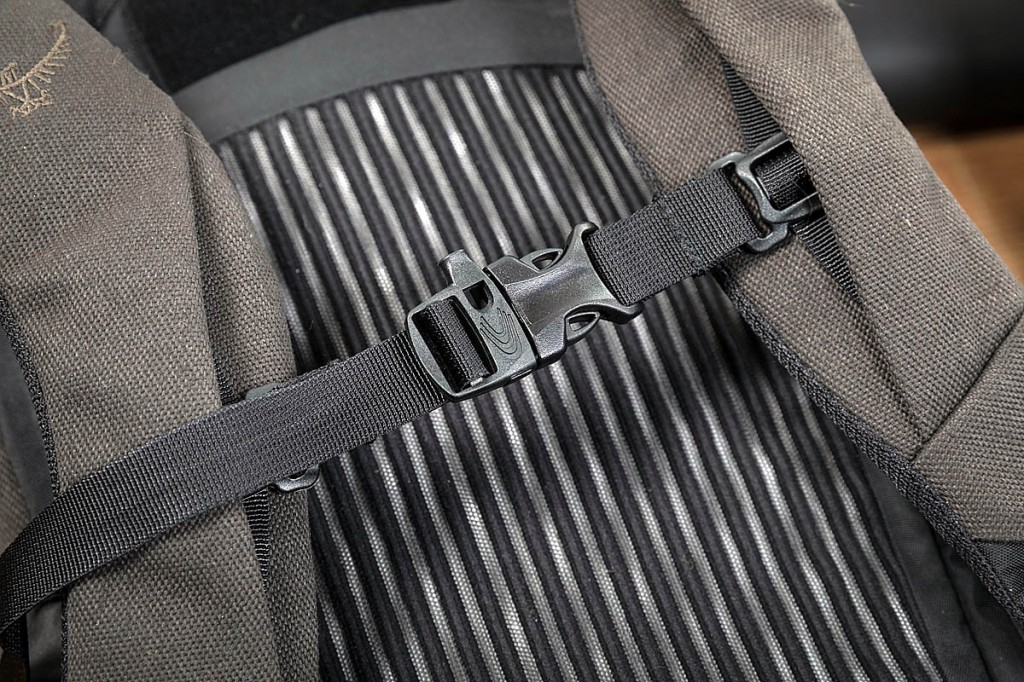A rucksack with a capacity of between 30 and 45 litres should be able to serve as your sole pack for use in most circumstances, unless you’re planning a big multi-day trip.
It’s not too big for use as a daypack but has enough space for use in winter hill activities when you need to pack extra clothing and gear.
At the top end of the size range, these rucksacks will hold enough gear for a lightweight camping expedition.
If your budget runs only to one rucksack, we reckon this size will give you enough flexibility for all your forays into the UK hills and countryside.
We put eight packs to the test, ranging from 30 litres at the bottom end of the range, up to a big 45 litre rucksack that we used on a multi-day wild camping hillwalking trip. As you’d expect, the price range is fairly wide too. We’ve rated the packs not just on their retail price, but on how good their value for money represents, judged on quality, likely longevity and performance.
We evaluated the packs for performance and comfort with a fairly sizeable load and in a variety of environments, from moorland to mountain, and in a typical mix of British weather.
Berghaus Arrow 30
Price: £60
Weight: 715g
Country of manufacture: Vietnam
Colour: blue
Rated capacity: 30 litres
Women’s version: no
The Arrow 30 is a conventionally styled compact rucksack with a single main compartment plus two zipped side pockets. It also has a lid with medium-sized zipped compartment.
The Berghaus pack is made from sturdy-feeling ripstop polyester.
Entry to the main area is via a standard top opening, with a drawcord fastening. The lid fastens down over the top of the pack via a single plastic buckle connecting to a broad webbing strap. This strap also has four daisy chain-style loops at its lower section to which you can attach gear using a carabiner if required.
The main compartment is uncluttered and contains just the pouch for a hydration reservoir with a hook-and-loop strip hanger. The drink tube exit is central, allowing the tube to be routed down either the left or right harness strap.
The lid compartment is a reasonable size and contains a plastic key loop.
On each side of the pack are two long pockets with zipped closures protected by storm flaps. These can be used to stash items you might need to access without opening up the main compartment. They are also big enough to take a one-litre drinks bottle.
The base of the Berghaus pack contains a rain cover, which is tethered and has an elasticated hem. This kept the cover in place, even in windy conditions. The rain cover compartment has a hook-and-loop strip for closure.
The Arrow 30 has twin walking pole or ice-axe loops, with bungee retainers at the upper positions. These locked securely round poles.
The rucksack has no frame or substantial back stiffening, so is not suitable for carrying a heavy load but, as its capacity is 30 litres, it’s unlikely you’d be overburdening the pack.
Its back uses Berghaus’s Flow system, with two ventilated and articulated foam pads running the length of the rucksack, with a channel between them to allow some air to flow.
The harness straps are quite wide and have ventilated foam padding. The sternum strap’s height can be adjusted using four different daisy chain loops. This involves unhooking each side and repositioning in an alternative loop, which is less convenient than anchors that slide up and down on rails. The hipbelt is a wide webbing strap with elasticated retainer loops for excess length.
The Berghaus pack is conventional in both design and features. It has good carrying capacity but isn’t the best for heavier loads. Everything worked well and the rucksack was comfortable, though the back system didn’t allow a great deal of venting and there was some build-up of perspiration after prolonged use.
The Arrow 30’s material is robust and should resist wear well. It’s a good all-round pack – unexceptional but it did the job. Capacity should be enough for day walks in both winter conditions and on warmer outings when less gear needs to be carried. It was also the lightest in the test, so won’t add too much to the burden on the body when heading up the hills.
Best use: mountain walking; hillwalking; countryside walking; winter walking
Performance 23/30
Comfort 23/30
Features 14/20
Quality 8/10
Value for money 8/10
Total score: 76/100
Craghoppers 40 litre Duffel Bag
Price: £90
Weight: 689g
Country of manufacture: China
Colour: black
Rated capacity: 40 litres
Women’s version: no
The Craghoppers pack is essentially a duffel bag that can be configured to use as a rucksack, as well as worn over a shoulder.
Its design enables the pack to be used in different ways and also has security features for travellers.
The main area is a good sized compartment accessed via a double zip, opening to three-quarters of the bag’s back. The zip pullers have eyelets for passing through a small padlock and there is also a metal loop at the bottom of the pack through which the padlock can also be threaded for extra security. The zip is puncture resistant.
The Craghoppers pack can be converted into a shoulder bag easily by unclipping the harness straps from the twin outer plastic loops and refastening into the larger central loop at the end of the bag. The loops can then be tucked into short fabric sleeves to minimise the risk of snagging.
The harness-shoulder straps can be unclipped and removed if required, to be stashed inside the pack.
A broad webbing strap runs the length of the back, with a central section that forms a grab handle if needed. On the top of the pack is a more substantial foam-padded grab handle. At the other end of the bag is a sturdy webbing handle.
The base of the duffel has another zip opening giving access to a separated compartment that is useful for a pair of shoes or similar. This keeps them apart from the contents of the main area, though it does share the space.
There are two more zipped pockets accessible from the outside of the pack, one of which has RFID protection for contactless cards and similar, and the other with soft lining to protect the contents.
Inside the main compartment, there’s a key loop with a spring gate on a short webbing strap. There are also two more zipped pockets, one mesh and one fabric, for smaller items.
The fabric of the Craghoppers Duffel is robust feeling polyester with a polyurethane coating. It contains recycled materials – the brand says about 14 plastic bottles were reused in its manufacture.
The Duffel has a good capacity and plenty of extra little pockets for odds and ends. The externally accessed shoe compartment is a good idea and there’s lots of potential security built into the bag for a traveller’s reassurance.
The ability to configure its carrying arrangement is useful, but in rucksack form, with the straps forming a harness, it’s awkward to adjust the length while wearing it on the back. The webbing straps don’t pull through the buckles smoothly, so I found the best option was to set the harness to the desired length and then slip it onto the shoulders. The excess webbing tends to flap about a little too.
There is no hipbelt or sternum strap, so all the weight is borne on the shoulders and the straps can slide if you’re moving over anything like technical terrain. There are two movable foam pads on the straps to provide some comfort, but carrying a full load over any long distance without the support of a hipbelt caused some discomfort.
But the Craghoppers Duffel isn’t really designed with this as its primary purpose. As a carryall for the traveller it works well. You can use the straps conventionally as a shoulder bag for short carries, and there are plenty of alternative handles to grab the duffel with. For a longer stroll across town to a hotel or venue, the straps can be brought into play as a rucksack harness, which makes carrying much easier.
If you wanted to limit your luggage to just one bag, the Craghoppers Duffel does give the opportunity to carry it rucksack-style for short walks, but we wouldn’t recommend its use for prolonged hillwalking. It’s also small enough for some airlines’ cabin luggage limits, though you would need to check with individual companies. Its dimensions are: 55cmx35cmx25cm. It enables flexibility in a holdall that can also be used backpack-style.
The use of recycled materials in its main fabric earns some green points too.
Best use: domestic and overseas travel, city walking, short country walks.
Performance 22/30
Comfort 21/30
Features 17/20
Quality 7/10
Value for money 7/10
Total score: 74/100
Gregory Arrio 30
Price: £95
Weight: 930g
Country of manufacture: Philippines
Colour: black
Rated capacity: 30 litres
Women’s version: no
The Arrio 30 is a compact daysack with a good load-carrying design.
It has an alloy frame that runs around the perimeter of the back, curving towards the centre in the mid-back section. The frame also curves away with a concave design from the user’s back at the mid-section with a suspended mesh panel allowing good ventilation. This mesh panel also supports the harness straps and the short hipbelt fins.
The main body fabric of the pack is a combination of 210 denier and 420 denier ripstop nylon, and feels robust and hard-wearing. Despite this, and the incorporation of a metal frame, Gregory has kept the weight of the 30 litre pack to less than 1kg.
The rucksack’s main compartment is accessed via a conventional top opening with drawcord closure. Inside it is a pouch for a hydration reservoir and a plastic hanger designed specifically for the brand’s own range, but which I was able to loop another brand of hydration system onto. Drink tube exit is to the right shoulder.
On the front of the Arrio 30, there is a separate, zipped, long pocket, big enough to stuff a wet waterproof jacket into if needed. On the other side is a smaller, zipped pocket. On the right side is an elasticated mesh pocket, which will take a drinks bottle.
There are twin top and bottom compression straps. These are made from narrow webbing to help keep the weight down, but worked well. The pack has a lower ice-axe or walking pole attachment loop, and there’s an upper bungee retainer. There is also a webbing loop for attaching a light.
Under the lid is a zipped pocket containing the rucksack’s rain cover. This has an elasticated hem to cinch it round the pack. Because it’s stashed in the lid, it can’t be tethered in the conventional way, it has a narrow retaining webbing strap that you pass under the back’s suspended mesh panel then hook onto a small loop at the other side. This was fiddly to accomplish quickly.
The lid has an external medium-sized, zipped pocket. The lid is secured in place by a single webbing strap and buckle.
The harness is well padded and shaped, and supports the load well and in comfort. The inner surface has a mesh covering, which allowed a good degree of breathability. There are load adjustment straps at the top of the harness, to pull the pack in closer to the body for stability. The sternum strap incorporates a whistle and its anchors slide up and down on rails. The right-hand side one also has a plastic clip to secure a hydration system drink tube to.
The hipbelt has short, ventilated fins and a centre section of webbing. Length adjustment is from the outside inwards.
The pack has PFC-free durable water resistant treatment. Its lining contains 40 per cent recycled polyester.
The Arrio 30 is well designed and quality is good. It’s a good size for a general daysack: not too big for shorter excursions but large enough for a big day in the hills. Comfort was very good, with the padded harness and hipbelt supporting the load well, and the FreeSpan suspended back providing ventilation.
The fabric is sturdy and stood up to knocks and scrapes well.
Best uses: day walks, mountain walking, short winter walks.
Performance 26/30
Comfort 26/30
Features 14/20
Quality 8/10
Value for money 8/10
Total score: 82/100
Lowe Alpine Cholatse 32:37
Price: £125
Weight: 1,502g
Country of manufacture: Vietnam
Colour: black
Rated capacity: 32 litres
Women’s version: yes, Cholatse ND30:35
This is the smallest pack in Lowe Alpine’s Cholatse range of load luggers.
It has good capacity for a medium rucksack and its back and harness support weight well. The Cholatse has a metal frame round the periphery of its back, and the harness adjusts for back length by loosening its large hook-and-loop areas and sliding the upper section up or down.
The central section of the Air Contour back has angled foam fins with a central channel, and these are covered by a honeycomb mesh. The shoulder area anchors the harness straps and these have generous foam padding and these are ventilated.
The lumbar area is made from the same ventilated foam, with very good padding at the base of the back. The hipbelt fins, also ventilated, lead out from the lumbar pad and are broad, with good load support. The central section of the hipbelt is webbing, with a plastic buckle. Length adjustment is from the outside inwards. Each hip fin contains a zipped, mesh pocket for small items.
The sternum strap has a whistle incorporated into its buckle. It is anchored each side by a toggle slotted into one of six daisy-chain loops. This is less easy to adjust for height than a sliding rail arrangement, especially while the pack is being worn.
The Cholatse has a good sized main compartment, accessible from a top opening with conventional drawcord. There’s also a compression strap across the top opening which can be used to secure a rope or other gear. The main compartment contains a hydration bladder pouch with hook-and-loop strip hanger. Drink-tube exit is to the right shoulder.
Usefully, there is also a three-quarter length zip opening on the left side of the front of the pack, which is handy for reaching contents without unfastening the lid and top closure.
The Lowe Alpine rucksack has a large external pocket on the front, with elasticated mesh sides, which is useful for stashing wet clothing or similar, to keep them separate from other pack contents. The front of the pack also has twin daisy chains, which can be used for attaching gear such as a helmet.
There are twin external drinks bottle pockets, with elasticated mesh sides. The pack has top and bottom compression straps.
The lid is secured by twin webbing straps with plastic buckles. Underneath it is a zipped pocket with key loop. The main pocket is medium-sized and has a rear zip opening.
In the base of the Lowe Alpine rucksack is a zipped compartment containing the rain cover. This is tethered by a hook-and-loop strap and has an elasticated drawstring to cinch it around the pack when in use. There are also twin toggles on its side, which hook into loops on the rucksack to help keep it in place and stop wind getting under the rain cover.
The Cholatse was among the most comfortable in the test when lugging a good load. The adjustable-length back, combined with good foam padding in the harness straps and hipbelt kept the rucksack in place well, while allowing some breathability. The metal frame helped the pack support a weighty load and gave the Lowe Alpine pack good stability over more technical ground.
Capacity was good too, and quality was good. The ripstop nylon, felt robust and resisted scuffing well.
Best uses: hillwalking; winter hillwalking; short lightweight backpacking trips; country walking.
Performance 27/30
Comfort 27/30
Features 14/20
Quality 8/10
Value for money 7/10
Total score: 83/100
Mammut Trion Nordwand 38
Price: £135
Weight: 1,011g
Country of manufacture: Vietnam
Colour: black
Rated capacity: 38 litres
Women’s version: no
Despite its good capacity and robust feel, the Trion Nordwand tips the scales at only just over a kilo. It demonstrates Mammut’s alpine heritage, with features useful to both climbers and walkers.
The shape of the pack is markedly tapered towards its lower end. The Trion Norwand 38 is built on the brand’s Motion V Frame, a metal member in a v-shape, which slots into a sleeve down the central part of the back, and which has two shoulder extensions that spread the load well at the top of the pack. The back worked well at supporting good loads.
The metal frame can be removed to save a little weight by unfastening a hook-and-loop strip in the main compartment and sliding the frame out.
The outer part of the back has twin foam pads, with a slightly more generously padded lumbar area. This made for good comfort but ventilation was only moderate, and there was a build-up of moisture when working hard uphill.
The upper part of the harness straps is foam padded. The straps are broad and shaped well to support the pack’s load. The lower sections are mesh and each has a small stretch pocket for small items. There a reflective retaining loop on the left strap, and two on the left one, useful for routing a drink tube through.
The sternum strap is unusual in that it consists of twin thin bungee cords with plastic buckles. Length adjustment is via spring toggles at the top of the small pockets, and the cord can be passed through three alternative daisy chain loops for height adjustment.
It actually works quite well, keeping the harness straps in position while allowing chest expansion when breathing hard.
The hipbelt is broad and has padded foam. Adjustment is from the outside inwards. The padded section can be slid out, leaving just the webbing, if required, to save more weight.
The Trion Nordwand uses Cordura fabric and feels very robust, despite its relatively light weight.
There are twin compression straps top and bottom and the pack also has sturdy ski attachment loops. The Mammut pack has walking pole attachment loops at the bottom, as well as ice-axe attachment points. At the top are hook-and-loop-fastening loops to retain ice-axes and poles. There are twin daisy-chain arrays for attaching extra gear and the top retaining loops can be repositioned in any of the daisy-chain locations.
On the right side of the exterior, there’s a small, zipped pocket with a key loop.
The main compartment is generously sized and swallowed a good load of my gear and clothing. Inside it is the pouch for a hydration reservoir, with small strap hanger with plastic buckle closure. Drink tube exit is to the right shoulder.
The main compartment is accessed by a roll-top closure with twin plastic buckles. The lid is a floating design that allows the pack’s capacity to be maximised by extending its retaining straps. The lid can be removed entirely if required, and the roll-top closure will keep the pack’s contents secured.
On the underside of the lid is a large, zipped mesh pocket and the main pocket, accessed from a rear zip, is also a good size.
There is no rain cover but the Mammut rucksack’s material has PFC-free durable water resistant treatment, which kept the rain out during our testing.
The Nordwand 38 is a well designed and well thought-out pack with an alpine heritage. It’s big enough for winter hillwalking or even longer alpine excursions and minimalist backpackers should even be able to accommodate enough gear for a multi-day trip.
It was comfortable with a good load on the back, supporting the weight well. The Norwand rucksack feels durable and sturdy and resisted scuffs and scrapes well.
It will serve hillwalkers and alpinists well and is versatile enough to be a general-use pack for most walkers and climbers.
Best uses: hillwalking, mountaineering, winter mountaineering, alpine climbing.
Performance 27/30
Comfort 25/30
Features 15/20
Quality 8/10
Value for money 7/10
Total score: 82/100
Osprey Archeon 45
Price: £220
Weight: 2,265g
Country of manufacture: Vietnam
Colour: black
Rated capacity: 45 litres
Women’s version: yes
The Archeon 45 is a big and beefy feeling pack, large enough for a multi-day walk.
The Osprey rucksack uses the brand’s recycled nylon canvas material. The 1,880 denier fabric gives the pack a retro look and feels very robust. The environmental considerations continue with the use of fluorocarbon-free durable water treatment on the material.
The brand has also used metal buckles for longevity, and the Archeon 45 has the feel of a rucksack that will serve its user for a good many years. And, of course, not having to replace gear is the best green recommendation and also saves on the pocket in the long run, though the Osprey pack does come at a pretty steep price.
Its design is pretty simple, with a large single compartment at its core. I managed to pack in my tent, stove, fuel, sleeping bag, sleep mat, food, spare clothing plus the odds and ends necessary when wild camping. The Archeon also accommodated my camera and a long lens, which usually accompany me on my mountain walks and, unfortunately add quite a bit to the load weight.
But the Archeon 45 is designed to carry a good load. The pack is designed to carry up to 15kg. Its back has a semi-rigid plate with twin metal frame elements, which also serve as sliders for the back-height adjustment system. This has hook-and-loop strips for securing the back in the desired position. The outer back panel is slightly curved and has narrow longitudinal ridges covering a mesh layer and behind that a layer of foam backing.
It’s not overendowed with padding but was comfortable over long distances. The back shape allowed some ventilation, though not as much as some of the rucksacks. However, with heavy loads it’s more important to keep the pack pretty close in to the body to improve balance.
The harness has a moderate amount of foam padding, as does the lumbar pad at the bottom of the back. It wasn’t as comfortable as those with more foam filling, but the straps were wide enough to support the load well. There are load adjusters at the top of the harness to enable the pack to be pulled in closer to the back.
The hipbelt has wide fins, with fairly slender foam padding. The fins are quite rigid, which allowed good load bearing, and they have cut-out sections to the main foam areas to permit some flexing, though the hipbelt could be felt when stepping up on to high moves. The central section of the belt is wide webbing with plastic buckles. Tightening is from the outside inwards, which I find enables a better tension to be obtained. There are no retaining loops for excess webbing, so I just tucked this under the belt when on the move.
Each hip fin has a reasonable-sized zipped pocket, made from solid material.
The harness’ sternum strap moves up and down on webbing straps each side and the plastic buckle incorporates a whistle.
The Archeon 45’s main compartment can be accessed conventionally via a top opening with drawcord. But it also has a useful twin zip arrangement down the front, which allows contents to be reached from the front of the pack. I find this especially useful in the tent, when you can lay the rucksack on its back and easily reach contents at the bottom end of the main compartment. When the top opening is cinched this is less easy but the left-hand zip also has a second puller so you can open this from the bottom and reach in without unfastening the lid and the drawcord. The compartment also has an internal strap and buckle, which helps keep contents in place if you use the zipped opening. It also helps keep the front of the pack in shape.
On the inner side of the front panel is a mesh pocket, divided in two but with a single zip opener. Also in the main compartment is a pouch for a hydration reservoir, with a webbing hanger. Exit for the drink tube is central, with the tube being able to be routed towards either the right or left harness strap.
The top opening of the main compartment is a conventional drawcord. There’s also a narrow webbing strap with metal hook buckle that can be used to secure a rope as well as cinching in the top opening.
The lid has a zipped mesh pocket on its underside, which also has a plastic key loop. The outer pocket of the lid is a good size, with a rear zip. There are also four strong webbing loops on the top of the lid for attaching extra gear.
The lid is secured in place by webbing straps with metal hook buckles and webbing loops. Though these are likely to be more durable than plastic buckles, they are a little slower to use, particularly when unfastening as you need to release a little of the tension on the buckle before you can unhook it.
There are twin ice-axe loops on the front of the rucksack. The pack also has upper and lower compression straps, again with metal hooks. These can also be used to secure walking poles to the pack.
There are twin stretch mesh pockets for drinks bottles or similar. These have both top and side entries, the latter being useful for accessing a bottle while on the move, without taking off the pack.
The Archon 45 has a raincover, which stashes in a zipped pocket on the base of the rucksack. The cover has an elasticated hem with drawcord to keep it in place while on the pack, and it’s tethered by a short webbing strap.
The Osprey rucksack comes with a steep price, but its quality and tough components suggest it will have a long life and will stand up to outings in tough, mountain environments.
It coped with carrying a substantial load on a wild camping expedition, with good weight bearing and just enough capacity for such an outing. Comfort was good, even though there isn’t a huge amount of foam padding on the harness and hipbelt.
It benefits from a simple design with a roomy main area, while the front zip opening was very useful for digging out items without having to undo the lid and main drawcord.
The recycled content, PFC-free treatment and expected longevity give the Archeon 45 good marks for green credentials.
Best uses: multi-day backpacking; mountain walking; winter walking; winter mountaineering; hillwalking.
Performance 27/30
Comfort 24/30
Features 15/20
Quality 9/10
Value for money 7/10
Total score: 82/100
Salewa Alp Trainer 35+3
Price: £135
Weight: 1,443g
Country of manufacture: Vietnam
Colour: blue/orange
Rated capacity: 35 litres
Women’s version: no
Salewa says the Alp Trainer has been designed for those outings where you need to carry extra kit.
It has a good sized main compartment and a floating lid that can be raised a little to allow extra gear to be accommodated if necessary.
The Dry Back Air system allows a good gap between the pack and the user’s back. It has a metal frame, wide at the top and narrowing down to an anchor in a rigid plastic member at the base of the pack. There’s also a semi-rigid plate running the full length of the rucksack, all of which provides a very stable carrying set-up.
There’s a marked concave curve to the plate to allow the air gap, and the Dry Back Air system has twin vented padded elements with a large central aperture, plus two smaller one at the shoulder area. There are two lumbar pads with additional foam filling. These are the only parts in contact with the user’s back, and the system works well at reducing discomfort from perspiration. The only real drawback is a tendency of the pack to creak during movement because of the flexing of the components.
The harness staps have good foam padding with ventilation and also cut-out sections to minimise moisture build-up. The pack has load adjusters at the top of the harness and the sternum strap is semi elasticated and is adjustable for height by sliding up and down webbing straps in a daisy chain layout, enabling two different height options.
The hipbelt has the same ventilated foam construction as the harness, again with cut-outs. Length adjustment of the webbing sections is from the outside inwards. The right hipbelt has a small zipped pocket.
The Salewa rucksack uses a mixture of honeycomb-pattern and twill material, both 100 denier nylon. There’s a separate zipped lower compartment with a divider incorporating a drawstring which can be opened up to create a larger single area with the main compartment.
The pack has twin upper compression straps. These are narrow webbing in a v-formation, with a loop for tightening. There is also a bungee array on the front of the pack, the lower sections of which form the attachment loops for ice-axes or walking poles. There are upper bungee retainers with length adjustment for poles and axes.
The Alp Trainer has twin zipped pockets on its sides. These are quite long and can take an OS map. There are also two elasticated open pockets for drinks bottles. In the base of the pack is a zipped compartment containing a rain cover, tethered by a hook-and-loop strip, and with drawcord round its perimeter for cinching in to keep it in place.
The main compartment is accessed by a top opening with an inner drawcord closure and a second outer drawcord. Inside the compartment is a pouch for hydration bladder, with a hook-and-loop hanger. Drink tube exit is to the right shoulder.
There’s good capacity which, with the addition of the lower compartment, easily accommodated my gear for extended walks.
The lid is a floating design, enabling it to be raised a little to allow extra space to be used in the main compartment. There’s also a strap for retaining rope under the lid.
The lid itself has a zipped pocket on its underside, as well as a good sized main pocket accessed from a rear zip. There’s a key loop inside.
The Salewa rucksack is well designed and its back system supports a good weight while keeping an impressive amount of ventilation. It’s big enough to use on a lightweight backpacking hike over two or three days, but will also serve as a daypack and will come into its own on winter mountain excursions when extra clothing and gear needs to be taken.
Quality was good, and the pack has a robust feel to it. The only real niggle was the creaking noise emanating from the back system while on the move.
Best uses: hillwalking, winter hillwalking, lightweight backpacking, mountaineering, winter mountaineering.
Performance 26/30
Comfort 25/30
Features 15/20
Quality 9/10
Value for money 7/10
Total score: 82/100
Salomon Out Night 30+5
Price: £105
Weight: 796g
Country of manufacture: Vietnam
Colour: green
Rated capacity: 30 litres
Women’s version: yes, Out Night 28 + 5
The Salomon rucksack follows the brand’s fast and light ethos, with lots of weight-saving features, and is among the lightest in the test.
The back is built around a stiffened internal element that runs down the centre of the pack. This, combined with a fabric that has little stiffness, means heavy loads are less supported than some of the packs, but that’s not really what the design is about.
The Out Night has lots of features borrowed from running packs that enable items to be accessed on the move without taking the rucksack off.
The Salomon pack uses a nylon material for its main body which, despite its light weight, feels pretty tough.
The back has two main padded elements running down each side. These have cut-outs in the foam and are covered in mesh to aid ventilation. The hipbelt fins use the same mesh covered foam and are broad enough to support the load well and in comfort. There are small, zipped pockets on each fin, and the length adjustment on the central webbing is from the outside inwards. There are elasticated retaining loops for excess webbing.
The harness straps are lightly padded and are well ventilated, with small cut-outs and mesh covering. They are broad and shaped to provide a good level of comfort. The harness attaches to the pack at its lower end by a v-shaped webbing array, which allows upper body and arm movement while maintaining good balance. Length adjustment is by pulling up on the lower webbing strap which was fiddlier than the conventional method from the top of the harness, particularly when loosening the straps to take the pack off.
The right harness strap has a small stretch pocket with retaining bungee strap. This will take a soft 500ml drink flask. On the left strap is a small, zipped, stretch pocket. The sternum strap is elasticated to allow chest expansion and attaches to notched, plastic rails either side, so can be used either left- or right-handed. These work well when in place, but are a little fiddly to engage when fastening.
The front of the pack has a zipped, stretch pocket, useful for stashing wet gear in. On the left side of the front, a zip entry to the main compartment allows access to items without opening the main, top access. There’s a lightweight bungee cord at the bottom of the pack for attaching poles and on the other side of the Salomon rucksack is a narrow webbing attachment strap for an ice-axe. There are lightweight upper bungee attachments for these, in a daisy chain array that allows for different positioning. The daisy chains can also be used for attaching extra gear.
The pack has twin stretch bottle pockets on its sides. There is also a reflective loop for attaching a lamp.
Access to the main compartment, in addition to the side zip, is via a top opening with drawcord fastening. Inside it is a pouch for hydration bladder, with webbing hanger. Drink tube exit is to the right shoulder.
The lid is a floating design, allowing it to be raised a little if more space is needed in the main compartment. It can also be removed if required, and a small secondary flap covers the opening. The lid or the flap are secured in place by a narrow v-design webbing strap. The underside of the lid has a small, zipped pocket containing a key loop. An exterior zip gives access to the medium-sized main lid compartment.
The Out Night 30 + 5 and its female version the 28 + 5 will appeal to fast-moving walkers who want to keep weight to a minimum. Its lightweight fabric does allow heavier items to sag a little, but the pack was comfortable.
Despite the relative low amount of foam in the harness and hipbelt, they combined well to support the load, and the shaped helped spread the weight well, remaining comfortable over long periods. The rucksack hugged the body well.
The addition of harness and hip storage was welcome, with items such as sunglasses and snacks easily, necessitating the need for fewer stops to delve into the rucksack.
Back ventilation was moderate and there was some build-up of moisture when heading fast uphill. The durable water-resistant treatment on the pack was PFC-free.
Best uses: hillwalking, challenge walks, lightweight winter walking, country walking.
Performance 24/30
Comfort 24/30
Features 16/20
Quality 7/10
Value for money 7/10
Total score: 78/100
It was a close-run contest to gain the best in test accolade, but the Lowe Alpine rucksack just pipped four others to lead the pack. Its combination of comfort, good performance and quality won it first place.
Four different types of pack were very good too. The Gregory Arrio 30 rucksack represents good value for money for a well designed and quality daysack. The Mammut Trion Nordwand felt pretty bombproof and will appeal to those heading for the heights who need a good capacity.
The Osprey Archeon 45 is our pick for longer excursions where plenty of capacity for camping gear and clothing is needed for a few days in the mountains. Quality was excellent and, though it was the priciest in the test, it is built for longevity. The Salewa Alp Trainer 35+3 had great quality and some innovative features, along with plenty of capacity.
The Salomon Out Night 30+5 proved you can have a comfortable pack and still stay lightweight. The Berghaus Arrow 30 represents good value for money for an everyday daysack with good quality.
The Craghoppers 40 litre Duffel Bag was designed for a different purpose from the other packs. It had lots of capacity and served well for shorter trips where converting it from shoulder bag to rucksack style pack made for a more comfortable cross-town walk or perhaps a trip to the crag bottom with a load of gear.
- All the rucksacks were supplied to grough by the brands.
